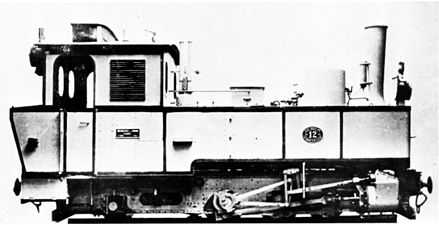South West African Class Ha
| South West African Class Ha 0-6-2T ex DSWA Class Ha 0-6-2T | |
|---|---|
|
Class Ha no 12, c. 1904 | |
| Type and origin | |
| Power type | Steam |
| Designer | Henschel and Son |
| Builder | Henschel and Son |
| Serial number | 6695-6704 [1] |
| Model | Class Ha |
| Build date | 1903 |
| Total produced | 10 |
| Specifications | |
| Configuration | 0-6-2T |
| Gauge | 600 mm (1 ft 11 5⁄8 in) narrow gauge |
| Driver diameter | 27 9⁄16 in (700 mm) |
| Length | 23 ft 6 11⁄16 in (7.180 m) |
| Locomotive weight | 21 6⁄20 long tons (21.6 t) |
| Fuel type | Coal |
| Boiler pressure | 171 psi (1,180 kPa) |
| Firegrate area | 8.6 sq ft (0.799 m2) |
| Cylinders | Two |
| Cylinder size |
11 13⁄16 in (300 mm) bore 13 25⁄32 in (350 mm) stroke |
| Valve gear | Allan |
| Performance figures | |
| Tractive effort | 8,928 lbf (40 kN) at 75% pressure |
| Career | |
| Operator(s) |
Otavi Mining and Railway Company South African Railways |
| Class | Otavi Class Ha |
| Number in class | 10 |
| Number(s) | 11-20 [1] |
| Delivered | 1904 |
| First run | 1904 [2] |
The South West African Class Ha 0-6-2T of 1904 is a South West African steam locomotive from the Deutsch-Südwest-Afrika era.
In 1904 the German administration in Deutsch-Südwest-Afrika, now Namibia, acquired ten Class Ha tank locomotives with a 0-6-2 wheel arrangement for the Otavi Mining and Railway Company. Only one of these locomotives survived to be taken onto the roster of the South African Railways after World War I.[2]
Manufacturer
Ten 600 millimetres (23.6 inches) narrow gauge 0-6-2 tank steam locomotives were built for the German administration in Deutsch-Südwest-Afrika (DSWA) by Henschel and Son in Germany in 1903. When delivered in 1904, they were designated Class Ha and numbered in the range from 11 to 20. They were leased to the Otavi Mining and Railway Company that operated a narrow gauge railway across the Namib Desert between Tsumeb and Swakopmund.[2]
The locomotives used Allan valve gear. Their "Ha" classification identified the locomotive type as the first class to have been built for DSWA by Henschel.[2]
South African Railways
During World War I the former German colony came under South African administration and the railways in DSWA came under control of the Union Defence Force. Control of all railway operations in South West Africa (SWA) was passed on from the Military to the Director of Railways in Windhoek on 1 August 1915. On 1 April 1922 all the railway lines and rolling stock in the territory became part of the South African Railways (SAR).[2]
Only one of these locomotives survived into the SAR era. It retained its German Colonial Ha classification and engine number while in SAR service.[2]
See also
- List of South African locomotive classes
- South African locomotive history
- The 0-6-2 wheel arrangement
References
|
